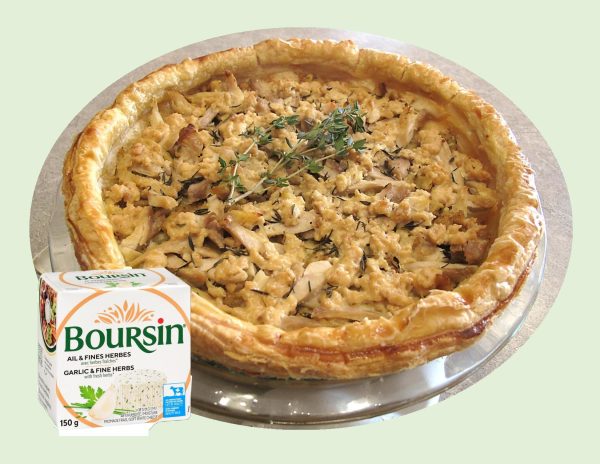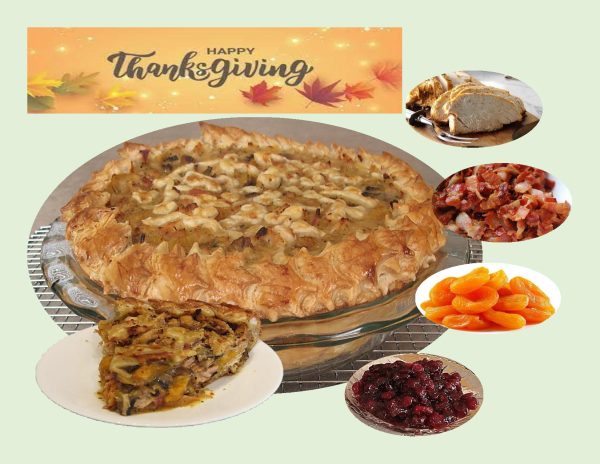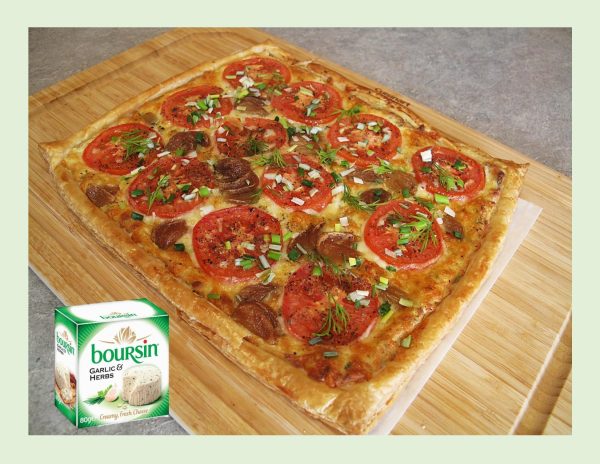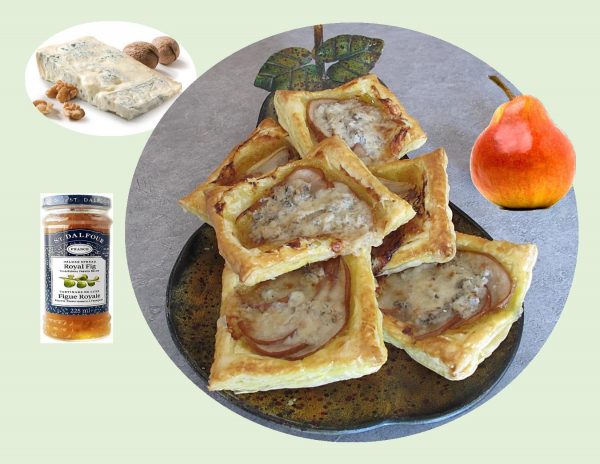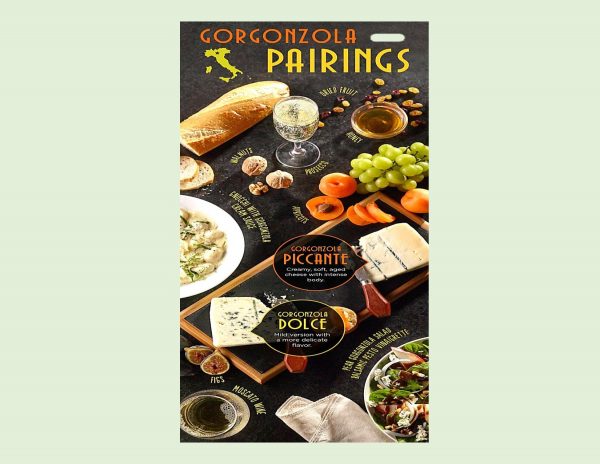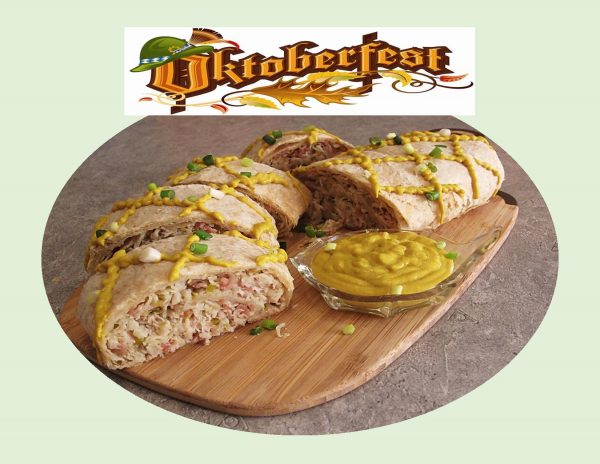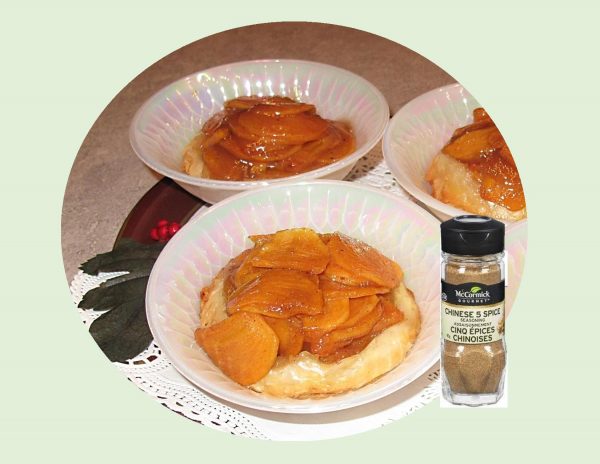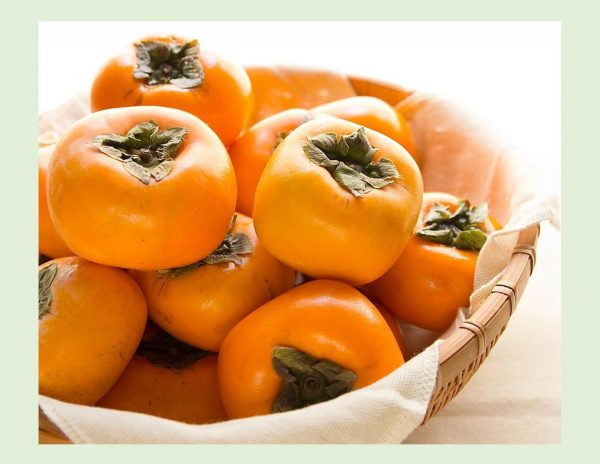
HAPPY EASTER!
Easter is here and Salmon Wellington is the perfect holiday meal! The richness of the mushroom duxelles, pairs perfectly with the hearty salmon fish fillet and scallops and the buttery puff pastry just takes this dish to the next level.
Mushroom duxelles is an intensely flavored combination of finely chopped mushrooms, shallots, and fresh herbs such as thyme or parsley that are slowly cooked to a paste-like consistency. French in origin and named after the marquis d’Uxelles, this mushroom condiment is traditionally used in the preparation of beef Wellington, but it can also be used to flavor soups and sauces as well as to fill omelets and ravioli.
Wellington fillet as we know it today was first made famous by the American chef and star Julia Child, who introduced the filet de bśuf en croûte, the French crust beef fillet, as ‘Filet of Wellington Beef’ during her TV show ‘The French Chef’, on the 1965 New Year’s Eve episode. From that day on, the recipe began to appear in various recreational circles in North America, as well as being taken up in the most important cookbooks.
A Salmon Wellington is a copycat version of the popular English ‘Beef Wellington’. Because puff pastry takes about 20 minutes to bake (salmon takes 12-15 minutes), keep the salmon refrigerated until you’re ready to assemble. Starting with cold salmon ensures it doesn’t overcook. To prevent the bottom from getting soggy, pat dry the salmon thoroughly before assembling. Also, make sure to cut slits on the puff pastry once assembled to allow the steam to escape. Don’t open the oven until ready since puff pastry needs full consistent heat to bake into flaky layers.
You’ll be so impressed when it’s time to take it out of the oven because it just looks amazing. However, you’ll be more impressed with how it tastes. Just like an elegant and flavorful fish pie!
Print Recipe
Salmon Wellington
Votes: 1
Rating: 5
You:
Rate this recipe!
|
|
Votes: 1
Rating: 5
You:
Rate this recipe!
|
Instructions
Mushroom Duxelles
In a food processor, pulse the mushrooms to a roughly diced consistency,15-20 seconds. In a saucepan, melt 2 Tbsp butter over medium-high heat. Add mushrooms, a heavy pinch of salt & pepper, shallots, garlic, rosemary & thyme. Sauté until moisture from the mushrooms has evaporated, about 15 minutes. Transfer to a bowl & set aside.
Scallop Filling
In a small bowl, combine the scallops (or shrimp), cream, onions, parsley, dill, garlic, pesto, salt & pepper. In another small bowl, beat egg white on medium speed until soft peaks form; fold into scallop mixture.
Assembly
Preheat oven to 400 F. Line a 15 x 10 x 1-inch baking sheet with parchment paper.
On a lightly floured surface, roll each pastry sheet into a 12 x 10-inch rectangle. Cut each sheet into FOUR- 6 x 5-inch rectangles. Divide mushroom mixture evenly & spread over 4 pieces of pastry leaving a 1/2-inch border.
Center the salmon pieces on top. Next, top each salmon piece with a quarter of the scallop filling.
Top each with a pastry rectangle & crimp to seal. With a sharp knife, cut several slits in the top to let steam escape. Place on the baking sheet & brush with egg wash. Bake for 20-25 minutes or until a thermometer reads 160 F.
Dill Cream Sauce
While salmon is baking, mix all sauce ingredients & refrigerate until serving time.

Our love affair with Boursin started about a year ago. Being cheese lovers I’m not sure why it took us so long to try it, but we are definitely under its spell now. Years ago, it was an imported delicacy from France, so creamy and so garlicky. Now made in Canada, and even though manufactured on an industrial scale, the garlic and herb Boursin is very similar to the French version.
It’s easy to understand why Boursin may well be the most popular flavored soft cheese in the world. More than 50 years later, the original recipe remains unchanged and food lovers in more than 35 countries have spread their passion for Boursin all around the world.
Boursin was developed by French cheesemaker Francois Boursin in 1957 in Normandy. He was inspired by a traditional fromage frais dish in which dinner guests use bowls of fine herbs to season their own cheese.
A major newspaper in France reported incorrectly that Boursin’s cheese was flavored with garlic. It was actually a competing cheesemaker who had introduced the garlic cheese. The newspaper article generated such interest and demand for garlic Boursin that the cheesemaker spent two years developing a garlic-flavored cheese—which was introduced in 1963 to quickly become a household name across France.
Not only was Boursin an excellent cheesemaker, but he also had marketing smarts. In 1968, Boursin made history as the first cheese featured in a TV ad campaign. It featured famous French comedian Jacques Duby cast in the role of the first ‘Boursinophile,’ a cheese lover unable to resist the alluring taste of Boursin whatever time of day or night. Waking in the middle of the night, he rushes to the fridge in his pajamas yelling for Boursin over and over again. You may recall seeing Boursin commercials on Canadian TV.
Today’s tart consists of a puff pastry shell encasing a layer of sweet caramelized red onion, topped with roughly broken up chunks of potato and chicken dotted with luscious Boursin. The tart is then baked in a creamy egg filling and sprinkled with a little thyme. Yum!
Print Recipe
Chicken, Potato, Boursin & Thyme Tart w/ Caramelized Onions
Votes: 1
Rating: 5
You:
Rate this recipe!
|
|
Votes: 1
Rating: 5
You:
Rate this recipe!
|
Instructions
Heat olive oil in a heavy based pot. Add onions, salt & pepper; cook over a medium heat for 20 minutes until soft, stirring occasionally.
Add balsamic vinegar & sugar, remove the lid; cook a further 10 minutes, stirring occasionally. Set aside to cool.
Put potatoes in a medium pot, cover with water, season with salt & bring to a boil. Reduce heat to a simmer, cook potatoes 15-20 minutes until just able to be pierced with a knife. Drain & set aside to cool.
Roll out pastry to fit a 10-inch round removable base tart tin. Pop in the freezer to chill.
-
Layer the onion, potato and chicken into the pastry shell. Dot with Boursin cheese and thyme. If you happen to be using left-over roast chicken & have a bit of stuffing spare, pop that in too! Whisk eggs and cream and pour over filling.
Bake for 35-40 minutes until the filling is set & pastry is golden.

Pastetli were invented in the early 1800s in Antonin Carême’s pastry store in Paris, France where they’re called vol-au-vent, French for ‘windblown’ to describe its lightness. While they’re served as an appetizer in France, they’re eaten as a main meal not only in Switzerland but also in Belgium and the Netherlands. It is also from the Netherlands where the Swiss name Pastetli origins from. The Dutch call them pasteitje (little pastry). From there it came to the German Pastete. Just to add a little complication though, a Pastete in Switzerland is rectangle cake shaped puff pastry pie filled with sausage meat, mushrooms in a creamy sauce.
A vol-au-vent is a light puff pastry shell that resembles a bowl with a lid. The shell is generally filled with a creamy sauce (most often a velouté sauce) containing vegetables, chicken, meat or fish. The lid is placed on the filled shell and the pastry is then served as an appetizer, also known as bouchée à la Reine, or as the main course of a meal. When prepared, the pastry dough is flattened and cut into two circles. A smaller circle is cut out of the center of one of the circles, which then will be used as the lid. The circle without the center cut and the circle with the center cut are then joined together around the edges so as the pastry bakes, it rises into a shell with a hole in the top. The lid, which is baked separately, is added later. The pastry shell may be made the size of an individual serving, or it can be made in several different sizes to become a main serving for one or a larger size to be served for more than one.
Vol-au-vents rose to prominence in Paris in the 19th century. In post-war Britain, they were a mainstay of any self-respecting buffet, served to suitably impressed guests alongside welcome drinks at dinner parties. By the 1990s, they had become unfashionable and remained so for decades. Updated vol-au-vents started reappearing in chic restaurants a year or two before the covid pandemic (2020) erupted and have become the retro appetizer or main course to have.
You can even adapt them to make some elegant desserts. Fill with cream and fresh fruit or melt a chocolate orange with a dash of Grand Marnier and orange zest then spoon this quick-fix mousse into the cases and top with sweetened Chantilly cream and chocolate shavings.
For our main course vol-au-vents, I am making an interesting filling which includes, chicken, shrimp, mushrooms and tiny meatballs. Sounds a little odd but is packed with flavor.
Print Recipe
Chicken, Veal & Shrimp Pastetli (Vol-Au-Vent)
Votes: 1
Rating: 5
You:
Rate this recipe!
|
|
Votes: 1
Rating: 5
You:
Rate this recipe!
|
Instructions
Chicken/Broth
Add the rosemary, garlic, bay leaves, cloves, chopped celery, carrot and onion to a stock pot. Season generously with pepper and salt. Cut the chicken up: legs, wings and breasts. Also chop up the remaining carcass. Add it all to the pot. Then fill it with water (about 7 cups) until the chicken is fully submerged.
Place the pot over high heat until boiling, then leave it there for 10 minutes. Turn the heat lower and gently cook the chicken for about 30 minutes. Remove the chicken from the heat and let it cool down for another 45 minutes.
Mushrooms/ Shrimp/ Cheese
Chop the mushrooms into bite-size pieces. Peel & devein shrimp. Grate parmesan cheese.
Puff Pastry Shells
-
Cut (4) 5-inch circles from puff pastry. Beat the egg & prick holes in the large circles with a fork & brush with egg. Cut 12 more RINGS from pastry about an inch wide. Lay a ring on each of the 4 circles & brush with egg wash. Repeat this until there are 3 rings on each large circle. Bake the puff pastry shells for 25 minutes.
Finish the Broth
Remove the cooked chicken from the hot stock. Reserve stock for later. Remove any chicken skin, bones, veins, cartilage, or sinew (discard all this) & pick the cooked meat from the bones. Shred the larger bits up roughly. Then transfer the chicken meat to a large saucepan.
Strain the chicken stock in a fine sieve or colander over a large pan. You should end up with about 6 cups (1,4 l) of chicken stock. Discard the cooked vegetables.
Meatballs
In a bowl, combine ground veal (pork), salt & pepper, egg & breadcrumbs. Mix well and make tiny balls of ½ oz (15 g) each. You should end up with about 20 of them. Cover the meatballs with cling film and store them in the fridge until later.
Bring the stock to a gentle boil again. Once warm, add the meatballs, shrimp & mushrooms.
Poach them for about 5 minutes. Then remove the meatballs, shrimp & mushrooms using a slotted spoon. Add them to the shredded chicken in the large saucepan.
Béchamel Sauce
Take the chicken stock off the heat now. In a large saucepan melt the butter over medium heat. Add the flour and whisk well until you get a wet crumble. Gently cook this over medium-low heat for about a minute. Then gradually add splashes of the warm chicken stock until you get a sticky flour paste. Keep stirring. Don't add too much at once or the sauce will become lumpy.
Whisk well. Gradually add more chicken stock (about 3 to 4 cups) until you get a pretty runny sauce. Bring the sauce to a low simmer & cook for 3-4 minutes or until thickened. whisk in Montreal Steak Spice, onion salt, garlic powder, mustard & grated parmesan.
Add the béchamel sauce to the chicken, meatballs, shrimp & mushrooms. Stir carefully. Cover the pan for another 5 minutes and let the vol au vent filling warm through or place it back over very low heat.
Put the vol au vent puff pastry casings onto 4 serving plates. Top with the chicken, meatball, shrimp & mushroom filling. Garnish with chopped fresh parsley if desired. Serve the vol au vents hot.

HAPPY THANKSGIVING DAY!
For the last 66 years, Canada has celebrated Thanksgiving Day on the second Monday in October. It’s one of those holidays that tend to bring families together, both physically and emotionally. Unfortunately, though, in this highly technological age, it seems as if we have become more connected digitally than emotionally.
We have now entered into our Autumn season with all its breathtaking fall foliage. Part of Canada’s appeal is it’s four seasons that offer changing landscapes and temperatures. Fall also represents a time of change. As nature bursts with its fabulous fall foliage, it gives us a little bit of extra time to make the most of what we have left in this year before the grand finale.
I, for one, have always loved the changing seasons. That’s not to say that I like freezing cold and slippery roads but that I have come to understand the important role each one plays in the ‘big picture’. When Brion and I initially landscaped our property, careful consideration was given to what plants were planted. Over the years it has developed into a beautiful tapestry of color through our growing season.
Growing up on the farm, Fall was an especially busy time with the grain crops being harvested, garden vegetables being canned, frozen or just stored for use over the coming months. So much needed to be done before winter would set in. As a teenager it all just seemed like a lot of work. Even as hard as my parents worked at making a living from farming, I think they felt a real sense of satisfaction in what they were able to achieve. I realize now that even without being aware of it the visual beauty of the farmland at harvest was imprinted on me forever.
Most of us here in Canada, have far more things to be grateful for than not. I have fond memories of my wonderful parents, carefree childhood days with my siblings, having enjoyed a successful career, a loving husband, our home, the many wonderful world travels we have been able to enjoy together, but above all we are both in relatively good health. It is so important to just take the time and appreciate the blessings in our lives and make every day count.
For our Thanksgiving meal I am preparing a turkey, bacon & apricot pie. Should be good!
Print Recipe
Turkey, Bacon & Apricot Pie
Votes: 1
Rating: 5
You:
Rate this recipe!
|
|
Votes: 1
Rating: 5
You:
Rate this recipe!
|
Instructions
Heat the olive oil over medium-high heat in a large skillet. Add the bacon & cook until slightly crispy. Remove from pan with a slotted spoon to paper towel & set aside.
Add the onion to skillet & sauté over a low heat until soft but not colored. Add the mushrooms & cook until soft & any liquid has evaporated, add thyme; set aside.
Melt butter in skillet, then add the flour & stir over heat for 1 minute. Remove from the heat, gradually add the milk a little at a time, stirring well. Return to heat & bring to a boil; add turkey broth & stir. Simmer for 2-3 minutes; add seasonings.
Add bacon, turkey, apricots & mushroom mixture to the sauce. Stir well.
-
Roll 1 sheet of puff pastry to fit a DEEP 9-inch pie dish. From the second sheet of puff pastry cut pastry designs of your choice for top crust.
Spoon filling into pie dish & top with pastry designs. Brush pastry with egg wash & place in oven.
Bake for 30-40 minutes or until pastry is golden brown & filling is piping hot. Remove from oven & allow to cool slightly before serving.
Recipe Notes
- Don't hesitate to use your own spice combination in place of the coriander & cumin.
- Spiced cranberries make an extra special condiment for this meal.

Summer is a great time to try something different with local produce. Roasting tomatoes is a great way to add depth of flavor, texture and color to pizzas, pasta, salads and so much more! They also make the perfect side dish for almost any meal.
Slow roasting tomatoes allows most of the natural juices to stay locked in while still achieving a delicious, caramelized flavor that is much more complex and intense.
This tomato tart with Boursin and extra old cheddar is brimming with flavorful roasted tomatoes that bear an intensely concentrated essence and melds it all with a puff pastry crust.
Baking with puff pastry is as simple as thawing the dough, then unfolding it and laying it underneath or on top of something. It contributes so much to the overall recipe that you don’t have to add much to turn it into an inspired vegetarian dinner.
Which brings me todays blog recipe: a gorgeous, simple, peak-summery roasted tomato cheese tart. If you don’t have Boursin & extra old cheddar, use the cheese you have; if you want to add a sixth ingredient, caramelized onions never made anything worse.
Print Recipe
Roasted Tomato & Boursin Cheese Tart
Votes: 3
Rating: 4.33
You:
Rate this recipe!
|
|
Votes: 3
Rating: 4.33
You:
Rate this recipe!
|
Instructions
-
On a sheet of parchment paper, roll out puff pastry to 1/8-inch thickness into a rectangle about 9 x 12-inches. With a sharp knife, score pastry about 1/2-inch in from edges. This will puff up while baking & form a nice edge on the tart.
Spread the Boursin cheese over pastry but NOT on the border. Sprinkle grated cheese evenly over top. Lay tomato rounds over cheese layer. Nestle sliced garlic in between tomato rounds. Season with salt, pepper & Italian spice.
Bake until cheese is bubbly & crust is crispy, about 25-35 minutes. Sprinkle with fresh chives. Let rest for 5 minutes before serving & slicing.
Recipe Notes
To roast garlic:
- Remove papery outer skin from garlic (do not peel or separate cloves). Cut top off garlic head: brush with oil.
- Wrap bulb in heavy duty foil.
- Bake at 425 F. for 20 minutes or until softened.
- Cool for 10 minutes; squeeze softened garlic out of skins.
- Cut into slices.

The fall season seems to orchestrate a return to the kitchen, to lure us who enjoy to cook, back to the stove. With the cooler days and nights, heating up the oven and cooking or baking becomes conceivable once more.
Autumn fruits are everywhere and pears are definitely in season. Pears & Gorgonzola are such a great pairing. The crisp, sweet, sometimes-earthy, sometimes-citrusy flavor of pears is naturally enhanced by the unique rich flavor of this Italian blue cheese.
Gorgonzola is named after a town outside of Milan, Italy where it was originally made. This soft, creamy cheese with blue-green marbling has a slightly pungent, savory flavor. The main difference between the different types of blue cheeses, is the region or country that they are made in or what type of milk is used in them.
Neither Brion or I like the strong flavored blue cheeses, but we sure wouldn’t pass up Gorgonzola used in either a sweet or savory recipe. These little pastries are a great fall/winter dessert. A bit more fidgety than making a larger tart or pie but as always, I love individual desserts …. there just so special!
Print Recipe
Pear & Gorgonzola Pastries
Votes: 1
Rating: 5
You:
Rate this recipe!
|
|
Votes: 1
Rating: 5
You:
Rate this recipe!
|
Instructions
-
Unfold puff pastry sheet & cut into 3 long rectangles. Cut each rectangle into 3 equal size squares.
Transfer to a parchment lined baking sheet. Placing tarts about an inch apart. Score a crust about 1/2-inch from edge of each tart. Using a pastry brush, paint the egg wash just across the outer crust of each tart.
Divide fig jam between pastries. Spread jam across the center of each pastry, keeping it within the scored lines.
Place 3-4 slices of pear in the center of the pastry, overlapping them. Sprinkle with walnuts.
Divide the Gorgonzola between the pastries, gently pressing it into pears/walnuts.
Bake for 20-25 minutes or until edges are golden brown & pastry is baked through.
-
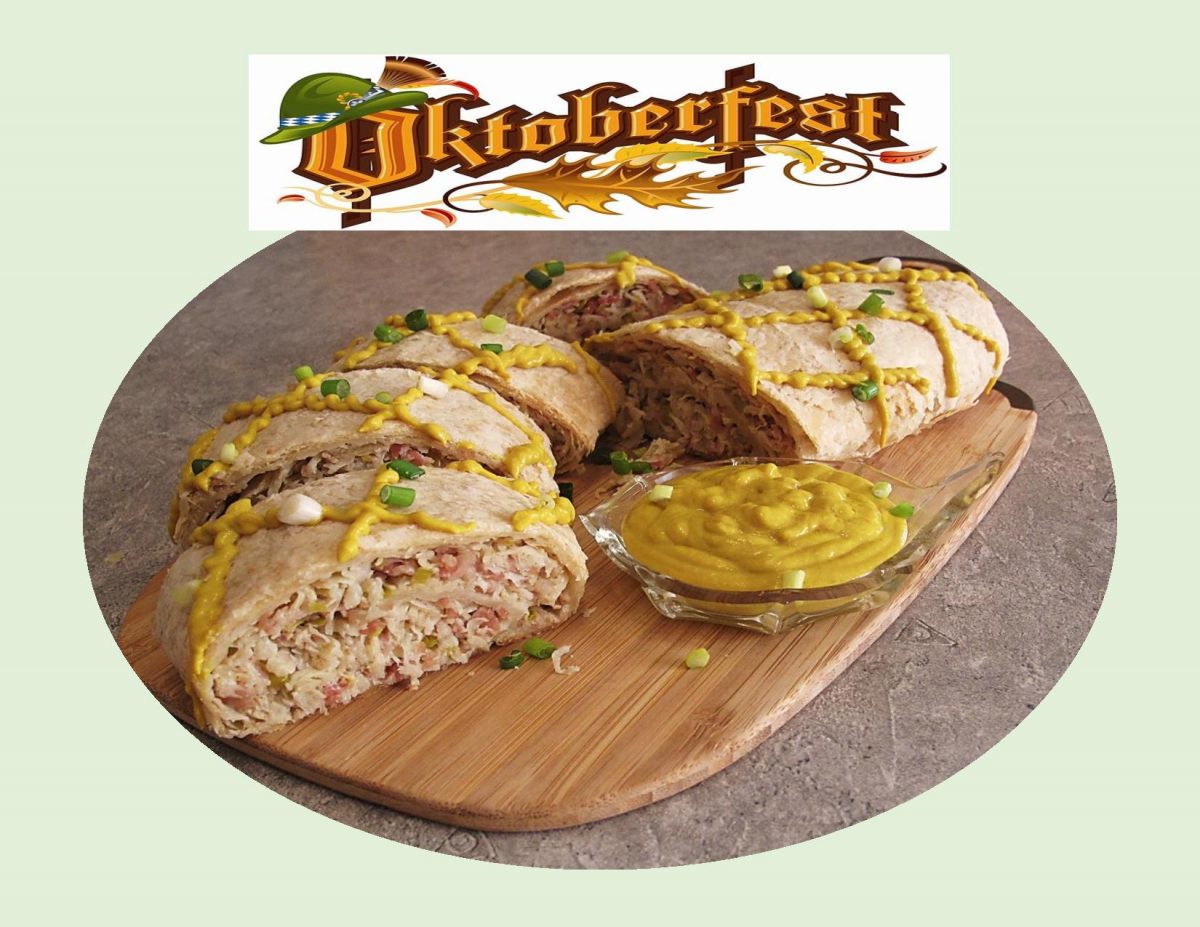
CELEBRATING OKTOBERFEST!
Sauerkraut strudel is a popular savory strudel version in beer gardens and during Oktoberfest which is the German fall folk fest celebrated during and after the harvest season.
A tradition dates back to 1810 in Munich, Germany. Originally a celebration of the marriage of the King of Bavaria and Princess Therese. Everybody had so much fun that it was resolved to repeat the celebration, which has been done, every year since. In 2022 it runs from September 17-October 3.
Oktoberfest is not only about the beer, singing, dancing and fair attractions. Many of the best known and most loved Bavarian specialties are enjoyed during the festival.
German strudels are not limited to the classic fruit fillings for the pastry. Savory examples are very common and this simplified sauerkraut strudel with soft sautéed strands of cabbage, the smoky flavor of bacon, and a savory crunch of caraway seeds; all wrapped in a delicate, flaky crust is a good representative.
Print Recipe
German Krautstrudel w/ Bacon
Votes: 1
Rating: 5
You:
Rate this recipe!
|
|
Votes: 1
Rating: 5
You:
Rate this recipe!
|
Instructions
-
Dice the bacon & cook in a pan over medium heat until it renders the fat but is not yet crispy. Drain on paper towel & sauté the diced onion in the rendered bacon fat. Cool down.
In a bowl combine the drained sauerkraut, bacon, onion, egg, bread crumbs & seasonings. Mix well together.
Roll out the puff pastry sheets, brush with half the melted butter. Reserve the rest.
Spread half of the sauerkraut mixture over each sheet, roll & pinch to tuck in the ends. Place each strudel seam side down onto a parchment paper lined baking sheet & brush with melted butter.
Bake for 35 minutes or until nicely golden brown. Allow to cool slightly before slicing with a serrated knife.
Serve with sour cream, sliced green onions or mustard as a dip.
Recipe Notes
- To make a STRUDEL DOUGH from scratch:
- Sift 2 cups of all-purpose flour into a bowl. Mix with 1 tsp of salt. Add a beaten egg, 2 tablespoons of vegetable oil and 2/3 cup lukewarm water.
- Mix well together and knead into a dough. Cover with plastic and let rest 30 minutes.
- Flour work surface and knead dough for a few minutes. Roll it out very thin.
- Flour one side of a large, kitchen towel, spread it out. Place the rolled out dough on top and using your hands stretch it out, aim for a rectangle shape, roughly 16 by 24 inches.
- Proceed as above and use the towel to help you roll the dough over the sauerkraut filling.
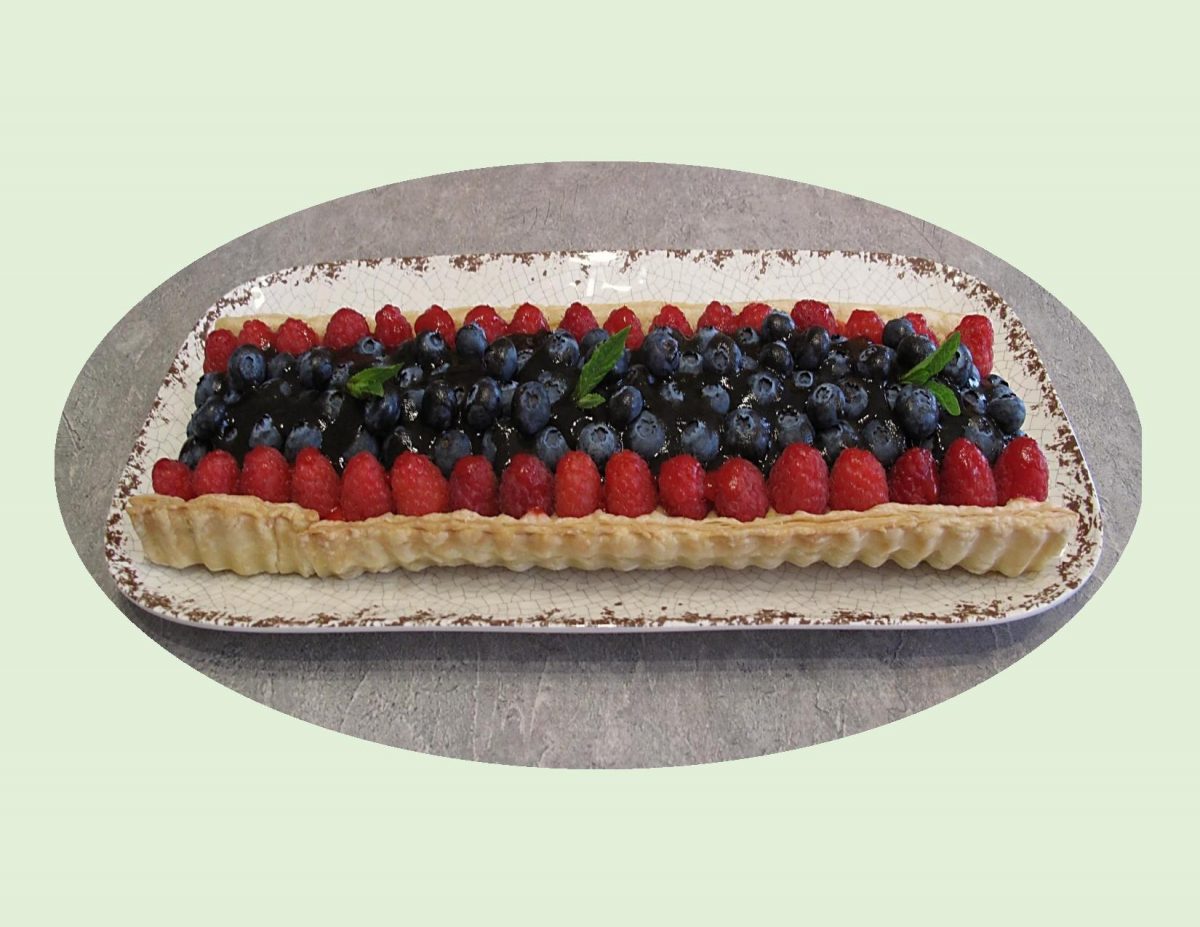
Glazed fresh fruit tart looks so elegant and summer-ish. They are the perfect dessert, whether your meal is casual or formal. In some ways, I guess its a version of a fruit pizza.
Apart from the fresh fruit and glaze, pastry cream adds a nice base to the tart. A custard pudding hybrid, pastry cream is used for ‘filling’, in the cold form, not as a pudding. Widely used to fill desserts like napoleons, cakes, cream puffs, tarts, etc.
To define, pastry cream is basically custard thickened with cornstarch and has a higher stability as compared to custard puddings which use just eggs to achieve their creamy texture. Vanilla is the classic flavor because it has to complete other flavors of the dessert. Pure vanilla is always best as the artificial flavorings add bitter taste profiles. In addition, some alcoholic desserts use pastry cream mixed with rum.
This tart has a layer of vanilla pastry cream, topped with raspberries and blueberries then brushed with an apricot glaze.
Print Recipe
Berry Custard Tart
Votes: 1
Rating: 5
You:
Rate this recipe!
|
|
Votes: 1
Rating: 5
You:
Rate this recipe!
|
Instructions
Pastry Cream
In a heavy saucepan, stir together the milk & 1/4 cup sugar. Bring to a boil over medium heat.
In a medium bowl, whisk together the egg yolks & egg. Stir together the remaining sugar & cornstarch; then stir them into the egg until smooth. When the milk comes to a boil, drizzle it into the bowl in a thin stream while mixing so that you don't cook the eggs. Return the mixture to the saucepan; slowly bring to a boil, stirring constantly so the eggs don't curdle or scorch on the bottom.
When the mixture comes to a boil & thickens, remove from the heat. Stir the butter & vanilla, mixing until the butter is completely blended in. Pour into a heat proof container & place a piece of plastic wrap directly on the surface to prevent a skin from forming. Refrigerate until chilled then beat until smooth with an electric mixer before using.
Other Prep Work
-
Line an oblong tart pan with thawed puff pastry. The short ends of the pastry should be even with the bottom of the pan but the long sides should come up to the top of pan sides. With a sharp knife, score the long sides where the sides meet the bottom of pan. Do not cut all the way through. Pierce the center of the pastry with a fork. Whisk together the egg and milk. Brush the edges of the pastry shell with the egg wash.
Bake the pastry shell for 15-20 minutes or until puffed and golden brown. Remove to a rack to cool completely. If needed, press the center down lightly to create an indentation. Cool while preparing filling.
Rinse & carefully dry fruit on paper towels. In a small blender, puree apricot preserves with water or liqueur until smooth.
Assembly
Place smooth pastry cream in a piping bag with a large flat tip. Carefully pipe pastry cream in long strips to cover the bottom ONLY of the puff pastry shell.
Arrange a row of raspberries down both sides of the tart; close to the edge & close to each other. Using a long straight edge helps to place the fruit in an even line.
To 1/3 of the apricot glaze add some red food coloring to help accent the natural color of the raspberries. Apply a couple of light coats of the glaze carefully to the raspberries.
Fill the center of the area with blueberries, being careful to distribute evenly in rows. Using the remainder of the un-colored apricot glaze, give several light coats to blueberries. Chill until ready to serve.

Browning, bruised and overlooked, you can’t help but feel bad for the half dozen persimmons nestled on the grocery shelf waiting to be selected. As I mentioned in an earlier post, there is no end to the ways persimmons can be used.
In this recipe, I used some Chinese five-spice to give the persimmons a spicy upgrade. With the unique flavor profile of this interesting spice, it often pulls double duty in savory and sweet dishes.
It seems that the exact origin of five-spice powder is unknown but there is some speculation that the blend was created in traditional Chinese medicine. A very unique spice blend that represents a wide range of flavors from sweet, salty and bitter to pungent and sour. Rumor has it that the Chinese were trying to create a ‘miracle powder’ that was representative of all the five elements: wood, fire, earth, metal and water. Then again, its possible that a cook accidentally stumbled upon this particular combination of spices and realized its power to improve on a bland dish. In any case, it is very versatile and can be used not only in cooking but also adds a unique flavor to baked goods.
Many recipes for five-spice powder exist but there is no one traditional recipe. Often the ingredients and amounts can vary from region to region and are different depending on the household and individual tastes. The original blend contained star anise, Szechuan peppercorns, fennel seed, cinnamon and cloves. A staple in Chinese cuisine but has also found its way into other international cuisines such as Vietnamese and Hawaiian food.
Print Recipe
Spiced Persimmon Tarte Tatin
Votes: 1
Rating: 5
You:
Rate this recipe!
|
|
Votes: 1
Rating: 5
You:
Rate this recipe!
|
Instructions
Preheat oven to 400 F. Lay puff pastry on a piece of parchment paper. Cover with plastic wrap; chill until needed.
In a skillet, melt butter & sprinkle sugar evenly over it. Add peeled, sliced persimmons & sauté until liquid is bubbling & lightly golden. Reduce heat & continue cooking until persimmons are tender. If you wish, thicken any juices with the cornstarch. Remove from heat & divide evenly into 6 ramekin dishes. Sprinkle persimmons evenly with five-spice & salt.
Cut 6 rounds from chilled puff pastry larger than the tops of the ramekin dishes. Place a pastry round over each dish of persimmons tucking edges down inside.
Bake until pastry is golden & cooked through, 20-25 minutes. Allow to cool then run a knife around edge of ramekin dish. Carefully but quickly invert onto a serving plate.





